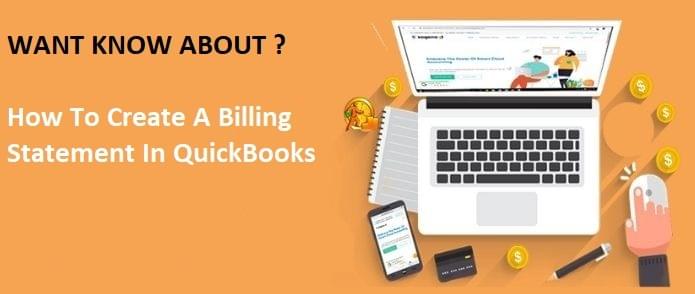
Creating Statement Charges in QuickBooks
Depending on what kind of business you have, you probably have a preferred method of billing customers. When they walk into your shop and present a credit card or cash, you create sales receipts. If they order off your site, they could receive an electronic receipt. Or your arrangement might be so that you send invoices.
There’s another way that is especially useful if for example the customers have the effect of paying recurring charges, like a continuing service contract that’s billed monthly. You can enter those financial obligations directly as statement charges.
Everbody knows, QuickBooks can create statements, summaries of a customer’s activity. These are generated automatically from the invoices, receipts, payments, and other transactions you’ve recorded over a given time period. But did you know you can easily manually add charges to statements? Here’s how it functions. If you want to know about How To Create A Billing Statement In QuickBooks then get in touch with our experts.
QuickBooks Desktop Statement Charges
Click the Statement Charges icon on the home page or open the shoppers menu and select Enter Statement Charges. Your Accounts Receivable register appears. Open the list on the go next to Customer:Job by clicking on the down arrow and select the best Customer:Job.
Important Note: If the item will be mounted on a particular job, not just a customer, be sure you pick the correct job. QuickBooks maintains an independent register for each.
Replace the date if necessary and open the Item list (or click <Add New> when you haven’t created an item record yet). Select the one you desire and enter a quantity (Qty). QuickBooks should fill out the rate and description. The kind column will automatically contain STMTCH (statement charge). Click Record when you’re done. Next time you create a statement for that Customer:Job, you’ll see the transaction you just entered.
Consider creating a statement charge in the place of an invoice for recurring transactions that will not be billed immediately.
Consider creating a statement charge rather than an invoice for recurring transactions that'll not be billed immediately.
Statement Charge Limitations
Before you decide to use statement charges, take into account that:
You can’t include some information that could appear on an invoice, like sales tax and discounts.
No matter if your charge relates to hours you worked for the customer, QuickBooks will likely not open a reminder window containing that information the next time you create an invoice when it comes to customer. You’d have to Enter Time by creating a single activity or going into the hours on a timesheet.
You've kept to bill the customers.
Billing the consumer
There are 2 techniques to bill customers for statement charges. You can, of course, just generate statements such as the date(s) of the charge(s). Next time you create a statement for customers who have manually-entered statement charges, it's going to contain them, along side any kind of activity like invoices and payments. We’ve covered statements before, but we’d be happy to go over this QuickBooks feature with you. This means you’ll have to enter a statement charge every month if it is to be a recurring one. Instead, you can easily treat them as memorized transactions, so they’re automatically entered in the register. If you’re billing multiple customers for similar service on a monthly basis, for example, this could work well.
First, you’ll need to create an organization which contains all those customers. Open the Lists menu and choose Memorized Transaction List. Right-click anywhere on that screen and click on New Group. This box will open.
In the event that you regularly bill customers for similar service, like a monthly subscription, you can create a Group and memorize the transactions.
If you regularly bill customers for the same service, like a monthly subscription, you are able to create a Group and memorize the transactions.
Give your Group a Name and click the button right in front of Automate Transaction Entry. Open the list into the field close to How Often and select the billing interval. Select the Next Date to indicate when this group billing must start. If the charges ought to be entered on a finite basis, go into the Number Remaining. And make certain to fill out the Days In Advance To Enter if that is applicable. Click OK.
Next, you’ll assign the customers who must certanly be billed monthly to your Group. Click Statement Charges in the home page again to open your A/R register. Select each customer one at the same time and right-click regarding the statement charge that you want to recur monthly, then select Memorize Stmt Charge. Within the window that opens, give the transaction a fresh Name if you’d like (this can not affect the transaction, only how it’s listed). Click the button right in front of Add to Group and select the Group name from the drop-down list. Repeat for each customer you wish to include.
Keeping Track
If periodic statements are much of your customer billing method, this method should work fine. But if additionally you send invoices and/or collect payment during the time of the sale, you’ll need to understand that your statement charges must be billed on a consistent basis, too. We are able to go over your customer billing procedures to you to determine whether you’re using QuickBooks’ tools wisely – or whether some changes could enhance your number of payments.